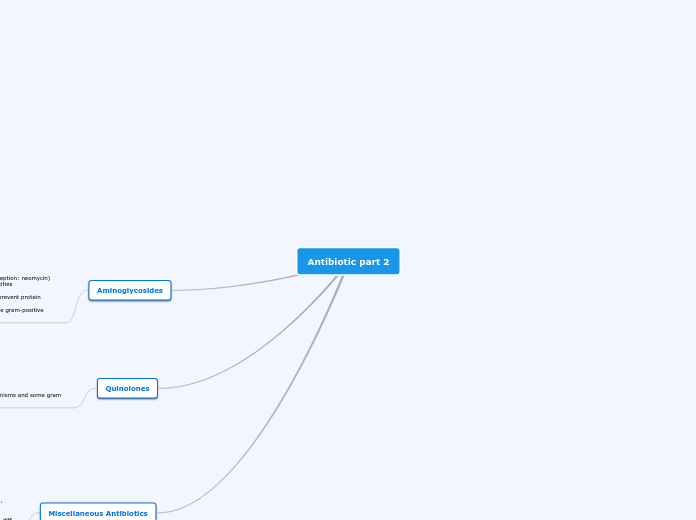Antibiotic part 2
Aminoglycosides
-natural and semisyntheric
-Produced from Steptomyces spp
-Poor oral absorption; no oral forms (exception: neomycin)
-very potent antibiotics with serious toxicities
-Bactericidal; prevent protein synthesis
-Kill mostly gram-negative bactericidal; prevent protein synthesis
-Kill mostly gram-negative bacteria; some gram-positive bateria
Drugs:
-Gentamicin
-Neomycin (Neo-Fradin)
-tobramycin (ToBI)
-amikacin
Used to kill gram-negative bacteria, such as pseudomonas spp
Escherichia coli, proteus spp, klebsiella spp, Serratia spp
-often used in combination with other antibiotics for synergistic effects (beta- lactams or vancomycin)
-Used for certain gram-positive infections that are resistanct to other antibiotics
-Aminoglycosides are poorly absorbed through the GI tract and are given parenterally.
-Exception: neomycin
>given orally to decontaminate the GI tract before surgical procedures
>Also used as an enema for this purpose
>Used to treat hepatic encephalopathy
Adverse Effects
-Cause serious toxicities
>Nephrotoxicity (renal damage)
>Ototoxicity (auditory impairment and vestibular impairment (8th cranial nerve)
-Must monitor drug levels to prevent toxicities
-Minimum inhibitory concentration (MIC)
-Therapeutic drug monitoring
-Ototoxicity and nephrotoxicity are the most significant
-Headache
-Paresthesia
-Fever
-Superinfections
-Vertigo
-Skin rash
-Dizziness
Therapeutic Drug Monitoring
-Serum levels measured to prevent toxicity
-Serum level needs to be at least eight times higher than the MIC
-Time dependent killing
-Concentration dependent killing
-Peak: highest drug levels for once daily regimens
-Trough: lowest to ensure adequate renal clearance of the drug and avoid toxicity
-Postantibiotic effects
-Resistance
-Drug interactions
Quinolones
-also called fluoroquinolones
-Excellent oral absorption
-Absorption reduced by antacids
-Effective against gram-negative organisms and some gram positive organisms
Medications:
-ciprofloxacin (Cipro)
-norfloxacin (noroxin)
-levofloxacin (Levaquin)
-moxifloxacin (avelox)
-Gemifloxacin (factive)
mechanism of action:
-Bactericidal
-Alter DNA of bacteria, causing death
-Do not affect human DNA
-Used to treat S. aureus, Serratia marcescens,
and Mycobacterium fortuitum
-Bacterial resistance to quinolone antibiotics: family that includes E. coli
Indications:
-Gram negative bacteria such as Pseudomonas
-Complicated urinary tract, respiratory, bone and joint,
GI, skin, and sexually transmitted infections
-Anthrax (ciprofloxacin)
Interactions:
-oral quinolones: antacids, calcium, magnesium, iron, zinc preparations, or sucralfate
-Patients need to take the interacting drugs at least 1 hour before or after taking quinolones.
-Dairy products
-Enteral tube feedings
-Probenecid
-Nitrofuraantoin
-Oral anticoagulants
Adverse Effects:
CNS; headache, dizziness, insomnia, depression, restlessness, convulsions
GI: Nausea, vomiting, diarrhea, constipation, thrush, increased liver function study results, others
Cardiac: Prolonged QT interval
Integumentary: Rash, pruritus, urticaria, flushing
Other: Ruptured tendons, tendonitis, fever chills, blurred vision, tinnitus
Miscellaneous Antibiotics
Clindamycin (Cleocin)
>Used for chronic bone infections, genitourinary infections, intraabdominal infections, other serious infections
>may cause pseudomembranous colitis (also known as antibiotic associated colitis, Clostriiu difficile diarrhea, or c. diff infection)
>Potential interaction with vecuronium
Linezolid (Zyvox)
-New class: oxazolidinomes
>used to treat vancomycin-resistant (Enterococcus faecium)VRE hospital acquired, and skin structure infections, including those with MRSA
>may cause hyptension, serotonin syndrome if taken with selective serotonin reuptake inhibitors (SSRIs) and reactions if taken with tyramine-containing foods
Metronidazole (Flagyl)
-used for aanaerobic organisms
-Intraabdominal and gynecologic infections
-Protozoal infections
-Several drug interactions
Nitrofuantoin (macrodantin)
-Primarily used for UTIs
-use carefully if renal function is impaired
-Drug concentrates in the urine
-May cause fatal hepatotozicity
Quinupristin dalfopristin (synercid)
-
